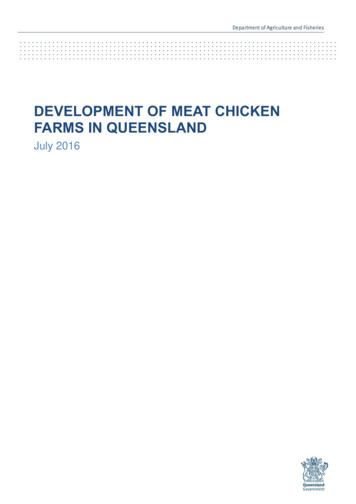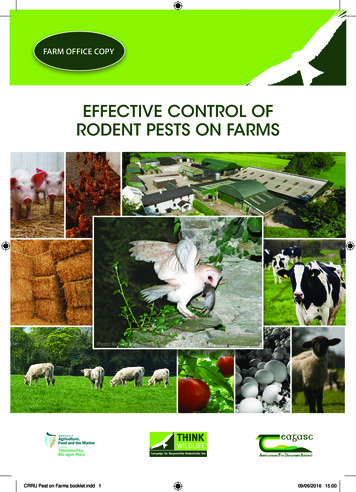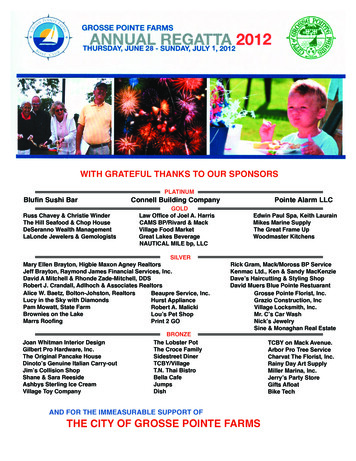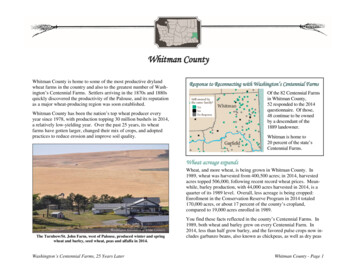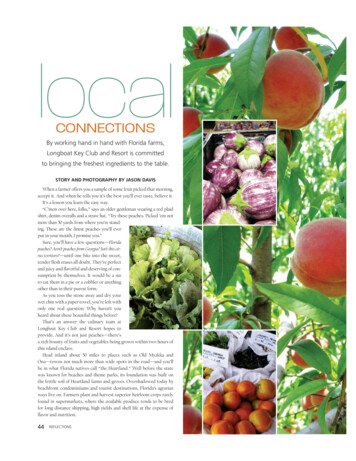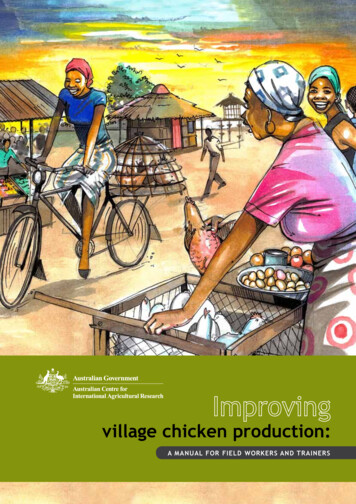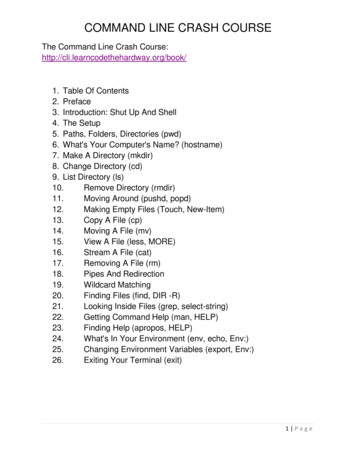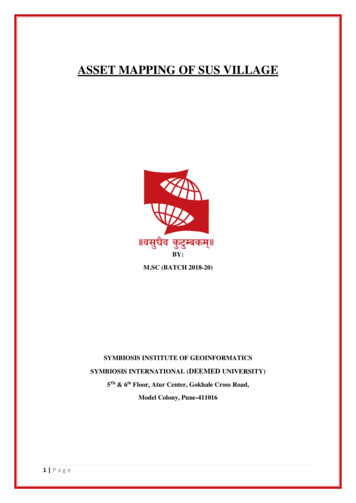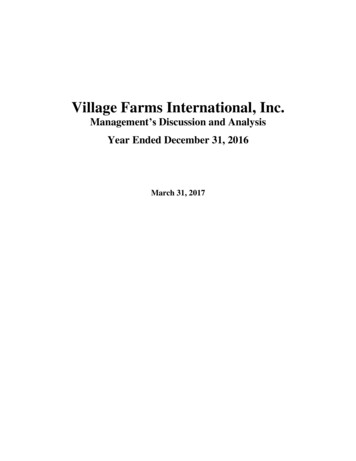
Transcription
Village Farms International, Inc.Management’s Discussion and AnalysisYear Ended December 31, 2016March 31, 2017
Management’s Discussion and AnalysisInformation is presented in thousands of United States dollars (“U.S. dollars”) unless otherwise noted.IntroductionThis management’s discussion and analysis (“MD&A”) should be read in conjunction with the annual consolidatedfinancial statements and accompanying notes of Village Farms International, Inc. (“VFF” and, together with itssubsidiaries, the “Company”), for the year ended December 31, 2016 (“the Consolidated Financial Statements”).The information provided in this MD&A is current to March 31, 2017 unless otherwise noted.VFF is a corporation existing under the Canada Business Corporations Act. The Company’s principal operatingsubsidiaries at December 31, 2016 were Village Farms Canada Limited Partnership (“VFCLP”), Village Farms, L.P.(“VFLP”) and VF Clean Energy, Inc. (“VFCE”).Basis of PresentationThe annual data included in the MD&A is presented in accordance with International Financial Reporting Standards(“IFRS”) as issued by the International Accounting Standards Board (“IASB”), unless otherwise noted.The preparation of annual financial data requires the use of certain accounting estimates. It also requiresmanagement to exercise its judgment in the process of applying the Company’s accounting policies. The areasinvolving a higher degree of judgment or complexity, or areas where assumptions and estimates are significant tothe annual financial data, are disclosed in note 3 of the Consolidated Financial Statements.Segment ReportingOperating segments are reported in a manner consistent with the internal reporting provided to the chief operatingdecision-maker. The chief operating decision-maker, who is responsible for allocating resources and assessingperformance of the operating segments, has been identified as the CEO. Based on the aggregation criteria in IFRS8, Operating Segments, the operating segments of the Company are treated as two reporting segments.Functional and Presentation CurrencyThe financial data is presented in U.S. dollars, which is the Company’s functional currency.information presented in U.S. dollars has been rounded to the nearest thousand.All financialBusiness OverviewManagement believes that the Company is one of the largest producers, marketers and distributors of premiumquality, greenhouse-grown tomatoes, bell peppers and cucumbers in North America. These premium products aregrown in sophisticated, highly intensive agricultural greenhouse facilities located in British Columbia and Texas.The Company also markets and distributes premium tomatoes, peppers and cucumbers produced under exclusivearrangements with other greenhouse producers. The Company primarily markets and distributes under its VillageFarms brand name, primarily to retail supermarkets and dedicated fresh food distribution companies throughout theUnited States and Canada. It currently operates two distribution centres, one located in the United States and one inCanada. Since its inception, the Company has been guided by a sustainable agriculture policy which integrates fourmain goals – environmental health, economic profitability and social and economic equality. The Company, throughits subsidiary VFCE, owns and operates a 7.0 MW power plant from landfill gas that generates electricity andprovides thermal heat, in colder months, to one of the Company’s adjacent British Columbia greenhouse facilitiesand sells electricity to British Columbia Hydro and Power Authority (“BC Hydro”).The Company embraces sustainable agriculture and environmentally-friendly growing practices by: utilizing integrated pest management techniques that use “beneficial bugs” to control unwanted pests. Theuse of natural biological control technology keeps plants and their products virtually free of chemical2
agents. The process includes regular monitoring techniques for threat identification, development ofappropriate, tailored response strategies and the execution of these strategies;capturing rainwater from various greenhouse roofs for irrigation purposes;capturing landfill gas on a long term contract from the City of Vancouver landfill to generate electricityunder a long term contract with BC Hydro and thermal heat for an adjacent greenhouse;recycling water and nutrients during the production process;growing plants in a natural medium, including coconut fibre and rock wool, as opposed to growing in thesoil and depleting nutrients; andusing dedicated environmental control computer systems which monitor and control virtually all aspects ofthe growing environment, thereby maximizing the efficient use of energy.The Company’s assets include seven greenhouses providing approximately 950,085 square metres (or approximately240 acres) of growing space in Canada and the United States. All of the Company’s greenhouses are constructed ofglass, aluminum and steel, and are located on land owned or leased by the Company. The Company also hasmarketing agreements with growers in Canada, United States and Mexico that currently operate approximately588,000 square metres (or approximately 147 acres) of growing area.The following table outlines the Company’s greenhouse facilities:Greenhouse FacilityMarfa, TX (2 greenhouses)Growing AreaSquareMetresAcres234,79560Fort Davis, TX (1 greenhouse)Monahans, TX (1 greenhouse)(Permian Basin facility)Delta, BC (3 85240Products GrownTomatoes on-the-vine, beefsteaktomatoes, specialty tomatoesSpecialty tomatoesTomatoes on-the-vine, long EnglishcucumbersTomatoes on-the-vine, beefsteaktomatoes, specialty tomatoesCrop CyclesThe growing cycle at the Company’s greenhouse facilities occurs over a 14-month period.Northern FacilitiesThe Canadian facilities begin their growing cycles in October of one year and extend through December of the nextyear. To start, seeds are purchased and sent to an external propagator in October. Meanwhile, harvesting for theprevious year’s crop concludes in November or early December. These plants are removed from the greenhouse andreplaced with new seedlings from the late October propagation. In early January, the pollination process begins andfruit typically begins to appear on the vines towards the end of January. The timing of growth and ripening of thefruit depends upon a number of factors, including variety and light levels, which vary from year to year. Harvestingof early varieties begins in March and reaches peak volumes during the months of June, July and August. InSeptember, volumes begin to decrease and continue to decline until harvesting is completed in late November orearly December.Southern FacilitiesThe Fort Davis and Marfa facilities begin their growing cycles in May of one year and extend into July of the nextyear. To start, seeds are purchased and sent to an external propagator in May. Meanwhile, harvesting for theprevious year’s crop concludes in late June or early July. These plants are removed from the greenhouse andreplaced with the new seedlings from May’s propagation. In August, the pollination process begins and fruittypically begins to appear on the vines. The timing of growth and ripening of the fruit depends on the variety of thefruit. Harvesting begins in late August into early September. In order to maintain the highest level of quality andyield, a portion of the facilities are planted with a second crop (interplant) alongside the original crop in January. In3
March, the second crop begins to harvest fruit and the original crop is removed. The Company also staggers its fallplanting cycle to manage its production volumes to ensure it has local Texas crop for some of its core customers.The Permian Basin facility, using GATES technology, started harvesting in mid-February 2012. The facilitychanges plants in smaller areas throughout the year to ensure product volumes year-round. Due to the southernlatitude, the light levels are sufficient to grow through the winter months and due to the enclosed growing climateand the technology of the GATES greenhouse, the extreme heat of the Texas summers typically has less of animpact on the produce than it does on the Company’s other Texas facilities, which are vented to the outsideenvironment. As such, the facility can produce premium quality tomatoes and cucumbers year-round.MarketingThe Company is a leading marketer of premium-quality, value-added, branded greenhouse-grown produce in NorthAmerica, and is a significant producer of tomatoes on-the-vine, beefsteak, cocktail, grape, cherry tomatoes, roma,Mini San Marzano (a tomato variety for which the Company currently has an exclusive agreement with the seedprovider to be the sole grower in North America), other speciality tomatoes under exclusive agreements and longEnglish cucumbers at its facilities. The Company also distributes and markets premium tomatoes, bell peppers andcucumbers in the United States and Canada produced by other greenhouse growers located in Canada and Mexico.The Company maintains high standards of food safety and requires the same of its contract growers, while providingon-time, effective and efficient distribution.The Company strives to continually exceed the expectations of its customers by consistently providing superiorproduct, including adding new product varieties and packaging innovations.The Company has distribution capabilities that it believes exceed those of most of its competitors in the NorthAmerican greenhouse vegetable industry. With leased distribution centres in Texas and British Columbia, theCompany provides its customers with flexibility in purchasing. For the year ended December 31, 2016, theCompany had an on-time delivery record of approximately 98.8%, while maintaining competitive freight rates thatmanagement of the Company believes to be among the best in the industry.The Company’s marketing strategy is to strategically position the Company to be the supplier of choice for retailersoffering greenhouse produce by focusing on the following: Year-Round Supplier.Year-round production capability of the Company enhances customerrelationships, resulting in more consistent pricing. Quality and Food Safety. Sales are made directly to retailers which ensure control of the product fromseed to customer and results in higher levels of food safety, shelf life and quality control. Food safety is anintegral part of the Company’s operations, and management believes that it has led, and currently leads, theindustry in adopting Good Agricultural Practices. This program is modeled after the U.S. Food and DrugAdministration’s Good Manufacturing Practices using the Primus Labs format and third party auditors.All of the Company’s packing facilities undergo comprehensive food safety audits by Primus Labs . Quality Packaging and Presentation. Product is selected at a uniform size and picked at the same stageof vine ripeness. The packaging for the product is “display ready”, ensuring retail customers have a fullview of the product on the supermarket shelf. Exclusive Varieties. The Company expands its product profile, to create and drive exclusive varietalrelationships in North America that enable the Company to present consumers with an enhanced eatingexperience with the Village Farms brand. Direct Sale to Retail Customers. Greenhouse produce (produce grown by the Company plus supplypartner produce) is sold directly to supermarket chains, including, Associated Wholesale Grocers, BJ’sWholesale Club Inc., Costco Wholesale, Fairway bakery LLC, Fred Meyer, Fresh Thyme Farmers Markets,The Fresh Market, Inc., Giant Eagle, Harris Teeter Supermarkets, Inc., HEB Grocery Company, TheKroger Co., Loblaw Companies Limited, Publix Super Markets, Inc., Roundy’s Supermarkets, Inc.,Safeway Inc., Sobeys Inc., Sam's Club, Trader Joe’s, United Supermarkets, Unified Western Grocers,Wakefern Food Corp., Wal-Mart Stores, Inc., Whole Foods Market and Winco Foods LLC. Excellence in Customer Service and Logistics. Logistics and distribution capability are key factors inensuring fresh high quality product meets consumer demands. Management of the Company believes it has4
a competitive advantage through its logistics and distribution networks, which includes strategically locateddistribution centres.Results of OperationsConsolidated Financial Performance(In thousands of U.S. dollars, except per Share amounts)SalesCost of salesSelling, general and administrative expensesChange in biological asset (1)Income from operationsInterest expense, netOther (expense) incomeExpense (recovery) of income taxesNet incomeEBITDA (2)Income per share/ basic and dilutedFor the three months endedDecember 31,20162015 37,308 610540(16)(354)287(780)4532,4863,5013,962 0.01 0.06(1) Biological assets consist of the Company’s produce on the vines at the period end. Details of the changes are described in note 7 of the Company’s condensed consolidatedinterim financial statements for the year ended December 31, 2016.(2) EBITDA is not a recognized earnings measure and does not have a standardized meaning prescribed by IFRS. Therefore, EBITDA may not be comparable to similar measurespresented by other issuers. See “Non-IFRS Measures”. Management believes that EBITDA is a useful supplemental measure in evaluating the performance of the Company.Results of Operations for the Three Months Ended December 31, 2016 compared to the Three Months EndedDecember 31, 2015SalesSales for the three months ended December 31, 2016 increased by 2,187, or 6%, to 37,308 from 35,121 for thethree months ended December 31, 2015. The increase in sales is primarily due to a 32% increase in supply partnerrevenue resulting from a 44% increase in supply partner volume. The increase in supply partner volume is due to thegrower agreement with Great Northern Hydroponics’ that took effect in the fall of 2015. The Company’s tomatoproduction decreased by (5%) and the Company’s cucumber pieces sold increased by 15% in the three monthsended December 31, 2016 versus the same period in 2015. The Company’s tomato production decrease was due tocrop issues at the Canadian facilities. The increase in cucumber pieces sold is a reflection of the continuedimprovements in growing techniques and climate control at the Company’s Permian Basin facility.The average selling price for tomatoes was flat for the three months ended December 31, 2016 versus the threemonths ended December 31, 2015; while prices for most of the tomato varieties were lower, this was offset byincreased volumes of higher priced specialty crops. Cucumber pricing decreased by (2%) and pepper pricingdecreased by (24%) in the fourth quarter of 2016 versus the comparable quarter in 2015.Cost of SalesCost of sales for the three months ended December 31, 2016 increased by 2,006, or 7%, to 31,891 from 29,885for the three months ended December 31, 2015. The increase is due to a 44% increase in supply partner productvolume versus the same period in 2015. The cost for the Company’s facilities during the quarter was flat versus thesame quarter in 2015.5
Selling, General and Administrative ExpensesSelling, general and administrative expenses for the three months ended December 31, 2016 increased 517, or15%, to 3,894 from 3,377 for the three months ended December 31, 2015. The increase is primarily the result ofan increase in sales and marketing personnel and marketing expenses.Change in Biological AssetThe net change in fair value of the biological asset for the three months ended December 31, 2016 decreased by( 898) to a loss of ( 157) from 741 for the three months ended December 31, 2015. The decrease is primarily dueto lower selling prices in January 2017 versus the same period in 2016 and lower production in January 2017 versusthe same period in 2016, due to recurring crop cycle changes at the Company’s year round Permian Basin facility.The fair value of the biological asset at December 31, 2016 is 4,446 and was 6,079 at December 31, 2015.Income from OperationsIncome from operations for the three months ended December 31, 2016 is 1,366, which was a decrease of ( 1,234)from 2,600 for the three months ended December 31, 2015. The decrease in operating results is due to the changein fair value of the biological asset and higher selling and marketing costs in the fourth quarter of 2016 versus thefourth quarter of 2015.Interest Expense, netInterest expense, net, for the three months ended December 31, 2016 increased by 70, to 610 from 540 for thethree months ended December 31, 2015. The increase is due to an increase in the interest rate on the Company’slong term debt versus the prior year.Income TaxesIncome tax expense for the three months ended December 31, 2016 was 287 compared to income tax (recovery) of( 780) for the three months ended December 31, 2015. The income tax expense in the fourth quarter of 2016 is aneffective tax rate of 39% and the recovery in 2015 is mostly related to unrealized foreign exchange for the Canadianoperations.Net incomeNet income for the three months ended December 31, 2016 decreased by ( 2,033) to 453 from 2,486 for the threemonths ended December 31, 2015. The decrease was the result of a decrease in the change in fair value of thebiological asset, an increase in selling, general and administrative expenses and a fourth quarter 2016 tax expense of 287 versus a fourth quarter 2015 income tax recovery of ( 780).EBITDAEBITDA for the three months ended December 31, 2016 decreased by ( 461), or (12%), to 3,501 from 3,962 forthe three months ended December 31, 2015, principally as a result of lower yields resulting from crop issues and anincrease in sales and marketing costs. See the EBITDA calculation in “Non-IFRS Measures - Reconciliation of NetIncome to EBITDA.”6
Annual Consolidated Financial Performance(in thousands, except per Share amounts)SalesCost of SalesSelling, general and administrativeChange in biological asset(1)Income (loss) from operationsInterest expense, netOther income (expense), net(Recovery of) income taxesNet (loss) incomeEBITDA(2)(Loss) earnings per share – basic and dilutedFor the year ended December 31,2016 ,983) 9,385( 0.05)2015 94 10,193 0.052014 7) 8,674 0.00(1) Biological assets consist of the Company’s produce on the vines at the period end. Details of the changes are described in note 7 of theConsolidated Financial Statements.(2) EBITDA is not a recognized earnings measure and does not have a standardized meaning prescribed by IFRS. Therefore, EBITDA may notbe comparable to similar measures presented by other issuers. See “Non-IFRS Measures”. Management believes that EBITDA is a usefulsupplemental measure in evaluating the performance of the Company.Results of Operations for the Year Ended December 31, 2016 Compared to the Year Ended December 31,2015SalesNet sales for the year ended December 31, 2016 increased 13,568, or 10%, to 155,502 compared to 141,934 forthe year ended December 31, 2015. The increase in net sales is due to an increase in supply partner revenues of57% over the comparable period in 2015. Company product revenues decreased (3%) for the year ended December31, 2016 versus the year ended December 31, 2015 due to lower tomato pounds as a result of crop issues primarilyrelating to TOV and beefsteak varieties at our Canadian facilities.The net price for all tomato pounds sold increased 2% for the year ended December 31, 2016 versus the year endedDecember 31, 2015, which was driven by an increase in the volume of higher priced specialty tomatoes sold.Pepper prices decreased (6%) while pepper pounds sold decreased (12%), in 2016, over the comparable period in2015. Cucumber prices increased 1% and cucumber p
Apr 04, 2017 · The Company’s marketing strategy is to strategically position the Company to be the supplier of choice for retailers . The Fresh Market, Inc., Giant Eagle, Harris Teeter Supermarkets, Inc., HEB Grocery Company, The Kroger Co., Loblaw Companies Limited, Publix Super Markets, Inc., Roundy’s Supermarkets,
